Overhead cranes are indispensable in various industries for lifting and moving heavy loads with precision and efficiency. Among these, the 50-ton overhead crane stands out as a powerful and versatile solution, capable of handling substantial weights. A critical aspect of ensuring the optimal performance of such cranes is understanding their power requirements. In this article, we delve into the key considerations surrounding the power demands of a 50-ton overhead crane, exploring the factors that influence energy consumption, efficiency, and overall operational costs.

Electrical Power Supply:
A 50-ton overhead crane typically relies on electrical power to drive its various components, including the hoist, trolley, and bridge movements. The electrical power supply is a crucial determinant in the crane’s overall performance, affecting its lifting capacity, speed, and precision. Cranes are commonly powered by either AC (alternating current) or DC (direct current), with the choice often influenced by specific industry requirements and preferences.
Voltage and Phase Requirements:
The power requirements for a 50-ton overhead crane include considerations of voltage and phase. The crane’s design and specifications dictate the voltage at which it operates, with common configurations ranging from 230V to 600V. Additionally, the phase requirement, whether single-phase or three-phase, plays a significant role in determining the efficiency and stability of crane operations. Most industrial applications opt for three-phase power systems due to their enhanced power transmission capabilities and reduced energy losses.
Frequency Considerations:
The frequency of the power supply also influences the operation of a 50-ton overhead crane. In many regions, a standard frequency of 50 or 60 Hertz is prevalent. The crane’s electrical components and control systems are designed to synchronize seamlessly with the local power frequency, ensuring consistent and reliable performance.
Power Consumption During Operation:
The power requirements of a 50-ton overhead crane vary during different phases of operation. While lifting and lowering heavy loads demand significant power, horizontal movements (trolley and bridge motions) consume comparatively less energy. The efficiency of the crane’s design, including the type of motors used and the control systems in place, directly impacts the overall power consumption during operation.
Efficiency Measures for Power Savings:
To enhance efficiency and reduce operational costs, manufacturers often incorporate energy-saving features into the design of 50-ton overhead cranes. Variable frequency drives (VFDs) allow for precise control of motor speeds, minimizing energy wastage during idle or low-load periods. Additionally, regenerative braking systems can convert excess energy generated during braking into electrical power, contributing to further energy savings.

Environmental Considerations:
As industries increasingly focus on sustainability, the power requirements of equipment like 50-ton overhead cranes come under scrutiny. Energy-efficient designs not only reduce operational costs but also align with environmental goals by minimizing carbon footprints. The use of energy-efficient components, LED lighting systems, and smart control technologies contribute to a more eco-friendly operation of double girder overhead cranes.
Backup Power Systems:
To ensure uninterrupted operations, 50-ton overhead cranes may be equipped with backup power systems. These systems, often in the form of uninterruptible power supply (UPS) units or generators, provide a temporary power source in the event of a primary power failure. This is particularly critical in industries where downtime can lead to substantial financial losses.
Power Factor Correction:
Power factor correction is a key consideration in optimizing the power requirements of a 50-ton overhead crane. Power factor measures the efficiency with which electrical power is converted into useful work. A low power factor indicates that a significant portion of the power supplied is lost as reactive power, leading to inefficiencies. Power factor correction devices can be employed to enhance the overall power factor, improving energy efficiency and reducing wasted power.
Maintenance Practices and Power Efficiency:
Regular maintenance is vital not only for the longevity of a 50-ton overhead crane but also for maintaining optimal power efficiency. Well-lubricated moving parts, properly tensioned belts, and clean electrical connections contribute to smooth operations and reduce the strain on the power system. Scheduled inspections and preventive maintenance practices help identify potential issues early, preventing energy wastage and unplanned downtime.
Conclusion:
In the realm of material handling, the 50-ton overhead crane stands as a stalwart solution for heavy lifting applications. Understanding its power requirements is paramount for ensuring both efficiency and sustainability. The careful selection of voltage, phase, and frequency, coupled with the incorporation of energy-saving features and maintenance best practices, contributes to the seamless operation of these cranes while minimizing their environmental impact. As industries evolve toward greener practices, the power considerations of 50-ton overhead cranes play a pivotal role in shaping the future of efficient and eco-friendly material handling solutions. To learn more, click here https://steelmillcranes.com/